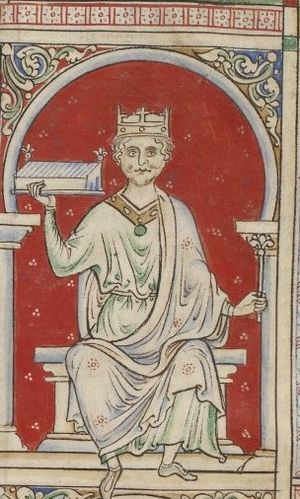Rebellion of 1088 facts for kids
The Rebellion of 1088 was a big fight that happened after William the Conqueror died. It was all about how his lands in England and Normandy would be split between his two sons, William Rufus and Robert Curthose. The fighting lasted for about three to six months, starting around Easter in 1088.
Contents
Why the Rebellion Started
William the Conqueror's Plan
When William the Conqueror was dying in 1087, he decided how his lands would be divided. His oldest son, Robert, became the Duke of Normandy. His third son, William Rufus (who was the second oldest still alive), became the King of England. This plan went into action after William the Conqueror passed away.
A Problem for the Nobles
Splitting William the Conqueror's lands into two parts caused a big problem for many important nobles. These nobles owned land in both England and Normandy. Since William Rufus and Robert were rivals, the nobles worried. They didn't know how to keep both their lords happy. They feared losing their land or their power from one or both rulers.
The Solution: One Ruler
The nobles thought there was only one way to solve this problem: England and Normandy needed to be ruled by just one person again. To make this happen, they decided to rebel against King William II. They wanted Robert to be the ruler of both places. The leader of this rebellion was a very powerful man named Odo of Bayeux. He was William the Conqueror's half-brother.
Who Was Involved
The main leaders of the rebels were Odo of Bayeux and Robert, Count of Mortain. Odo was the stronger leader. They wanted to remove young King William II and bring England and Normandy back together under Robert.
King William II had many supporters too. These included all the bishops in England and some important nobles like Alan Rufus, William de Warenne, 1st Earl of Surrey, and Hugh of Avranches.
However, many of the most powerful barons in England joined the rebels. Six out of the ten biggest landholders in England were part of the rebellion. They were spread all over the country, from Kent to Northumberland.
The Rebellion Begins
Rebels Attack
When summer arrived in 1088, the rebel barons started their plan. They attacked and destroyed the lands of King William II and his supporters. They also made their own castles stronger and filled them with supplies. They waited for the king to react. If he didn't, they planned to live by taking things from nearby areas. This would cause a lot of chaos, which the king would eventually have to deal with.
King William's Response
King William II reacted in three ways. First, he tried to divide his enemies. He promised money and land to anyone who would join him. Second, he asked the English people for help. He promised them "the best law that had ever been in this land." This helped local groups fight the rebels. Finally, he attacked the rebels himself.
Key Battles and End of the Rebellion
King William II laid siege to Pevensey Castle in Sussex for six weeks. During this siege, he captured Odo, the rebel leader.
The king also had some good luck. The troops Robert was sending from Normandy were stopped by bad weather at sea. Meanwhile, King William and his allies captured Rochester Castle in Kent. Since Robert's help never arrived, the rebels had to give up. The rebellion was over.
What Happened Next
Some of William's loyal nobles asked him to be kind to the rebel barons. They said that if he treated them well, they could be useful friends in the future.
Odo, who had been the richest man in England, lost everything he owned. He was sent away to Normandy for the rest of his life. His nephew, Robert Curthose, was allowed to stay in England and keep his lands in Normandy. But he had to agree that William II was the rightful king and give up his claim to the throne.
Roger of Montgomery, 1st Earl of Shrewsbury had left the rebels and joined the king. He was promised land and money. King William kept the nobles he needed and removed those who were a danger to him.
William de St-Calais, the Bishop of Durham, had left the king's army during the fighting. He was later put on trial, removed from his position, and sent away to Normandy. However, he returned in 1091 and got his position back.
Sources
- Carpenter, David (2004). The Struggle for Mastery: The Penguin History of Britain 1066–1284. New York: Penguin. ISBN: 0-14-014824-8.


